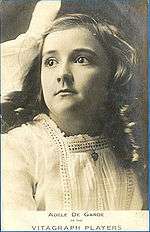Adele DeGarde
| Adele DeGarde | |
|---|---|
|
c1909 | |
| Born |
Adelaide De Gard May 3, 1899 Brooklyn, New York |
| Died |
November 1972 Brooklyn, New York |
| Other names | Adele De Garde |
| Occupation | Actor |
| Years active | 1908-1918 |
| Spouse(s) | Harry Jespersen |
Adele DeGarde (May 3, 1899 – November 1972),[1] aka Adele De Garde, was an American silent film actress, who appeared in 114 films between 1908 and 1918.
Born Adelaide De Gard in Brooklyn, New York, DeGarde was a Biograph Studios child star in the early part of the 20th century. Later she became a Vitagraph Studios leading lady.
In 1939, she attended an Old Home Week at Ohrbach's in New York with other movie actors such as Mae Murray and June Elvidge.[2]
Career
In 1908, when pictures were looked at with a bit of apprehension, DeGarde (at the age of eight) began to appear in Vitagraph Studios. And DeGarde and her little pal, Kenneth Casey, were the mischievous, spoiled, or ill-treated children around whom centered many a melodramatic plot. As new stars joined the Vitagraph forces, DeGarde and Kenneth played with them. Many a picture of the "two-generation" or "from-child-to-woman" type would open with DeGarde as its child heroine and finish with Leah Baird, Edith Storey, or Dorothy Kelly rounding out the plot when the child had grown up. If the good old days had been in the year 1918, we would have read about Kenneth Casey and DeGarde, co-stars, but their popularity and appeal suffered none whatsoever because of the fact that they were not heralded as co-stars. Many a Bunny comedy and many a Williams drama have been lightened effectively because of the two irrepressible ones. As the years grew, so did DeGarde, until finally she grew too large for little-girl-before-growing-up parts, and, with many sighs, her directors were forced to "pass her up" and cast anxious glances around for another promising child. Loath to part with their two clever little players, the company produced some exceedingly funny pictures enacted entirely by children about fourteen or fifteen. These comedies — for they were comedies — proved extremely popular, because of the fact that they were so typical of children at that age. And so the years flew, until DeGarde had outgrown even these kinds of parts. About a year ago, when Vitagraph was casting Within the Law, they were a trifle at a loss as to whom they should give the part of Aggie Lynch, a vivacious little parasite, a character on whom all the comedy relief of the play was dependent. After a careful study of the part, it was determined that DeGarde should have it, and those of you who have seen the Vitagraph Blue Ribbon Within the Law know how ably she portrayed the part. Hard-hearted New York press critics had nothing but lavish praise for her delineation of Aggie Lynch and pronounced it "a huge success," declaring that her portrayal equaled that of any of the well-known actresses who essayed the role on the legitimate stage. DeGarde was forced to delineate the character without the assistance of the witty and slangy lines that the stage made possible, but she "got it across in such a manner that even press critics had naught but good to say. DeGarde was the newest "O. Henry" girl, having given a most successful interpretation to the ingénue part in Whistling Dick's Christmas Stocking.[3]
Reviews for Within the Law
- Variety: "Adele DeGarde as Aggie Lynch, which in reality is nothing more than a comedy foil for the lead, had something on the star, judging from the impression she left on the minds of the audience."[4]
- Moving Picture World: "Adele DeGarde as Aggie Lynch must be credited with one of the best performances in the picture. In a character easy to overplay she strikes just the right note, and her amusing unmorality is always without offense."[5]
Filmography
|
 Adele DeGarde (1917)
|
References
- ↑ "Profile of Adele DeGarde". Young Hollywood Hall of Fame. Retrieved 2011-12-30.
- ↑ "none". Reno Evening Gazette. Associated Press. March 25, 1939.
- ↑ ""Where Are You Going, My Pretty Maid?" "I'm Going A-Filming," DeGarde Said". Motion Picture Magazine. May 1918. (Note: Out of copyright)
- ↑ "Review for Within the Law". Variety. May 4, 1917.
- ↑ "Review for Within the Law". Moving Picture World. May 19, 1917.
External links
| Wikimedia Commons has media related to Adele DeGarde. |
- Adele DeGarde at the Internet Movie Database
- Adele De Garde: A Brief Biography at Welcome to Silent Movies
